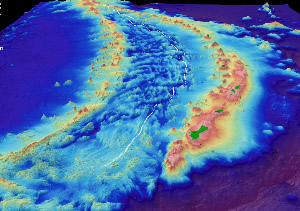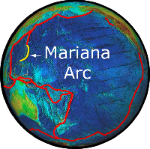
Marianas
The Mariana Volcanic Arc extends from 13°N to 23°N in the western Pacific Ocean, north of Guam. The Mariana region contains 9 volcanic islands and more than 60 submarine volcanoes, of which at least 20 are hydrothermally active. The summits of these submarine volcanoes range from 50 m to more than 1800 m below sea level. This one of the most active volcanic regions on Earth. Here, ocean crust that was born along the mid-ocean ridges millions of years ago in the eastern Pacific is “recycled” back into the Earth’s mantle as the ocean floor descends into the Mariana Trench. A portion of the ocean crust remelts and rises to the surface behind the trench along a line of submarine volcanoes and volcanic islands extending north of Guam for more than 1,000 kilometers. Many of the hydrothermally active sites we discovered are now part of the Mariana Trench Marine National Monument.
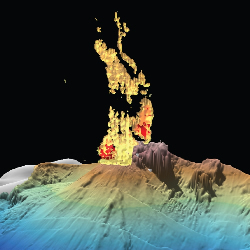 |
Visit the Mariana Arc virtually. Click on the image above to download a kmz file that can be opened in Google Earth. In Google Earth, click on the region or any of the seamounts (red triangles) for more information. |
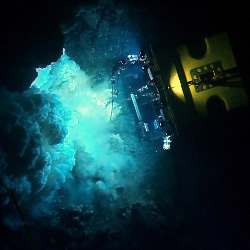 |
| Gas bubbles detected in the water column over NW Rota-1 using sonar mapping system. | Overhead view of ROV sampling at the erupting NW Rota-1 volcano. |
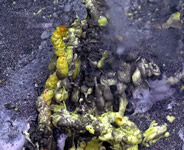 |
| Molten sulfur and gas bubbles at Daikoku, 2016. (click for video) |
Video Collection:
Earth-Ocean Interactions YouTube Playlists
Videos from EOI Program's expeditions to the seafloor using remotely operated vehicles are available now on YouTube:
Latest update:
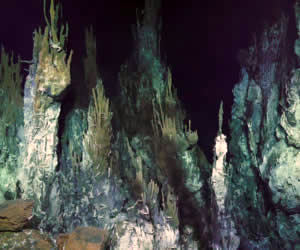 |
|
| Mariana Back-arc, Alba Vent site. Image from ROV SuBastian, SOI. | |
2016 Mariana back-arc, R/V Falkor Expedition/ROV SuBastian:
EOI and collaborators were the first scientists using the new Schmidt Ocean Institute’s ROV SuBastian aboard the R/V Falkor as they returned to the Marianaback-arc spreading system on an expedition from November 29 to December 20. This year's cruise follows up on discoveries made last year aboard R/V Falkor of new hydrothermal vent sites and lava flows in the Mariana back-arc. EOI also co-directed several NOAA Ship Okeanos ROV Deep Discoverer dives this past summer yielding some additional observations in this relatively unexplored region. ROV SuBastian will provide in-depth exploration and sampling of these systems to characterize their geologic setting, chemical environment, and biological communities. This expedition is supported by Schmidt Ocean Institute (SOI), NOAA's Ocean Exploration and Research Program, and the NOAA Pacific Islands Regional Office.
Learn more about the expedition at: Searching for Life in the Mariana Back-Arc (SOI).
View the expedition cruise report with or without dive logs (pdfs).
SOI provided the ship and support for this expedition. Additional support is provided by NOAA Office of Ocean Exploration and Research and NOAA Pacific Island Regional Office.
2015 Mariana back-arc, R/V Falkor Expedition:
EOI Scientists aboard the Schmidt Ocean Institute’s RV Falkor explored the Mariana back-arc spreading center (November 20 - December 17) and discovered four new hydrothermal vent sites. Researchers from NOAA and its cooperative institutes at the University of Washington and Oregon State University searched for these new hydrothermally active sites to gain a better understanding of the physical, chemical and geological forces that shape the biodiversity in these unique ecosystems. Scientists will return for a second cruise in the Fall of 2016 with a remotely operated vehicle to further characterize and sample the new vent sites.
Learn more about the expedition at:
Hydrothermal Hunt at Mariana (Schmidt Ocean Institute, SOI). Visit the video gallery from the expedition (SOI).
View the expedition cruise report here (pdf).
The Schmidt Ocean Institute provided the ship and support for this expedition. Additional support is provided by NOAA Office of Ocean Exploration and Research and NOAA Pacific Island Regional Office.
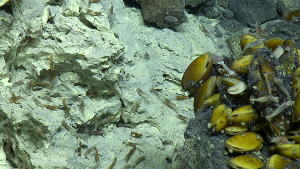 |
|
| NW Eifuku's Champagne Site. Numerous shrimp cluster near the sulfur deposits with mussels atop a rock outcrop above the venting. | |
2014 Submarine Ring of Fire 2014 - Ironman Expedition*:
The Jason ROV was used to make divesat the Snail and Urashima vent sites in the Mariana back-arc, and at NW Rota and NW Eifuku seamounts in the Mariana arc. The dives were very productive with the opportunity to make observations, collect samples, and conduct many experiments. Between Jason dives, other operations included CTD casts and tows to search for hydrothermal and eruptive plumes and collecting multibeam sonar data to map new areas and to look for depth changes at seamounts that had already been surveyed. We found many surprising changes showing that the Mariana arc is even more dynamic than we had thought! See a chronology of the expedition through the Mission Logs with great video clips on NOAA's Ocean Explorer web site.More information: Cruise website, Multimedia gallery
Cruise report (pdf format: with dive logs, 242 pages | without dive logs, 120 pages)
See underwater video highlights on the 2014 EOI YouTube playlist
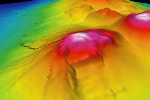 |
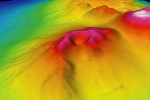 |
| 3D Bathymetry before (left) and after (right) the eruption. Click on image for full-size. | |
International Collaboration Yields Insights on Enigmatic Submarine Eruption: An article just published in Oceanography by PMEL’s Dr. Robert Embley and collaborators, describes the site of an enigmatic 2010 submarine eruption of a shallow (<200 m) seamount in the Mariana arc. Comparison of pre- (2002) and post- (2013) eruption bathymetric surveys reveals a new 400m diameter crater at the eruption site. This new map was used to target dives with a JAMSTEC remotely operated vehicle in June 2013. This new information will help to better evaluate the hazard potential of submarine eruptions. The paper can be downloaded at the Oceanography website.
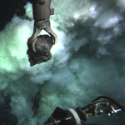 2010 NW Rota-1 Expedition**:
2010 NW Rota-1 Expedition**:
The 2010 expedition to NW Rota-1 seamount discovered that the active submarine volcano had experienced a major landslide since it was last visited in 2009. The event gave researchers an unprecedented view of how arc volcanoes grow by the cyclic process of eruption, collapse, and regrowth, how the volcano’s magmatic and hydrothermal systems responded to such a large perturbation, and how the resident chemosynthetic biological community was impacted.
More information: Cruise website, 2010 YouTube playlist, Cruise report (pdf)
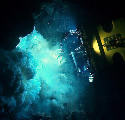 2009 NW Rota-1 Expedition**:
2009 NW Rota-1 Expedition**:
The 2009 expedition to NW Rota-1 seamount with ROV Jason discovered that the volcano had grown a new cone over the eruptive vent since 2006. The eruptive vent is now at the top of a large cone that a new bathymetric survey shows is as high as a 10 story building and as wide as a city block. The ecosystem has was thriving and the population of animals and microbes had increased dramatically relative to 2006, becoming more diverse, including new species that have not been found anywhere else. ROV dives made observations of the eruptive activity, collected geologic, chemical and biological samples, and deployed instruments.
More information: Cruise website, 2009 YouTube playlist, Cruise report (pdf)
Press release from the National Science Foundation
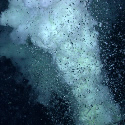 2006 Submarine Ring of Fire Expedition*:
2006 Submarine Ring of Fire Expedition*:
The 2006 expedition built on the results from 2003 and 2004 and explored additional hydrothermally active submarine volcanoes with a remotely operated vehicle (ROV). The on-going eruption of NW Rota-1 volcano was observed to be even more active than previous expeditions. New ecosystems were discovered and characterized and extraordinary sites from 2004 were revisited, providing new insights into their remarkable environments. The results from the 2003-2006 expeditions partly inspired the creation of the Mariana Trench Marine National Monument in 2009.
More information: Cruise website, Multimedia gallery, 2006 YouTube playlist, Cruise report (pdf)
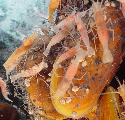 2004 Submarine Ring of Fire Expedition*:
2004 Submarine Ring of Fire Expedition*:
The 2004 expedition used a remotely operated vehicle (ROV) to explore some of the hydrothermally active submarine volcanoes mapped on the 2003 expedition. Discovery highlights include the first observations of an erupting submarine volcano, new ecosystems with new species, venting of liquid CO2, and pools of molten sulfur on the seafloor.
More information: Cruise website, Multimedia gallery, 2004 YouTube playlist, Cruise report (pdf)
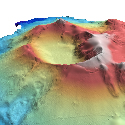 2003 Submarine Ring of Fire Expedition*:
2003 Submarine Ring of Fire Expedition*:
In 2003, the EOI Program conducted the first systematic survey 60 submarine volcanoes in the Mariana Arc. This expedition included multibeam and sidescan sonar mapping of the seafloor and a search for indications of hydrothermal venting in the water column above each volcano. It was found that about 30% of the Marianas submarine volcanoes were hydrothermally active.
More information: Cruise website, Multimedia gallery, Cruise report (pdf)
* Funded in part by NOAA's Ocean Exploration and Research Program
** Funded in part by the National Science Foundation
Link to list of PMEL publications from Mariana Expeditions

